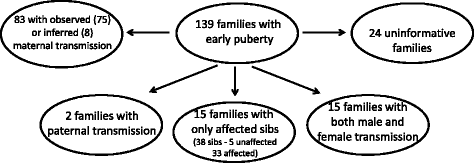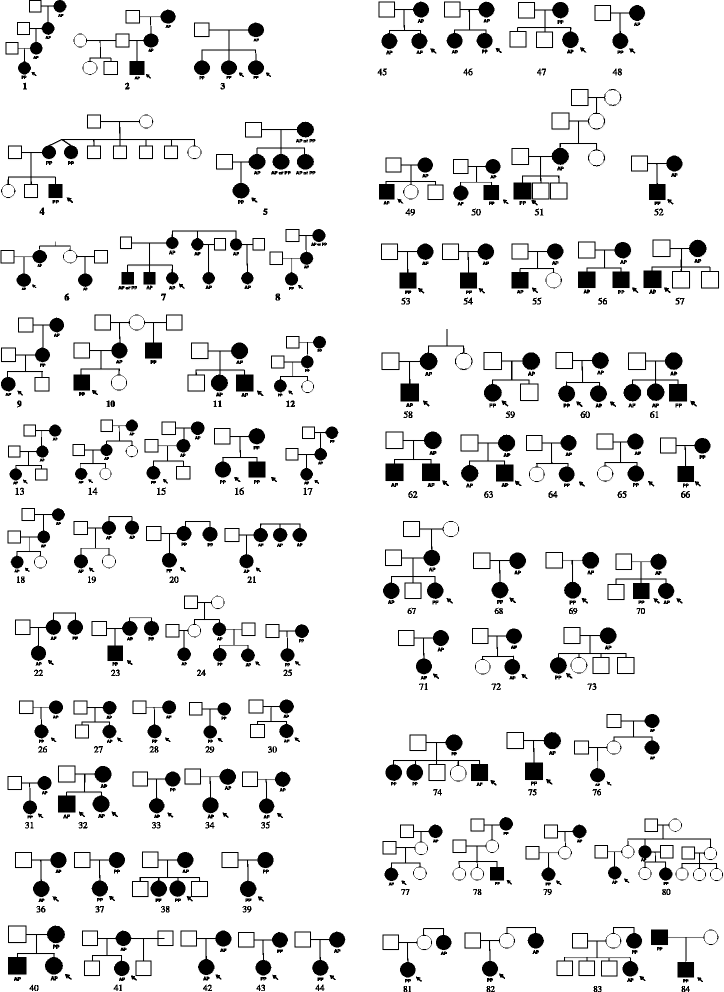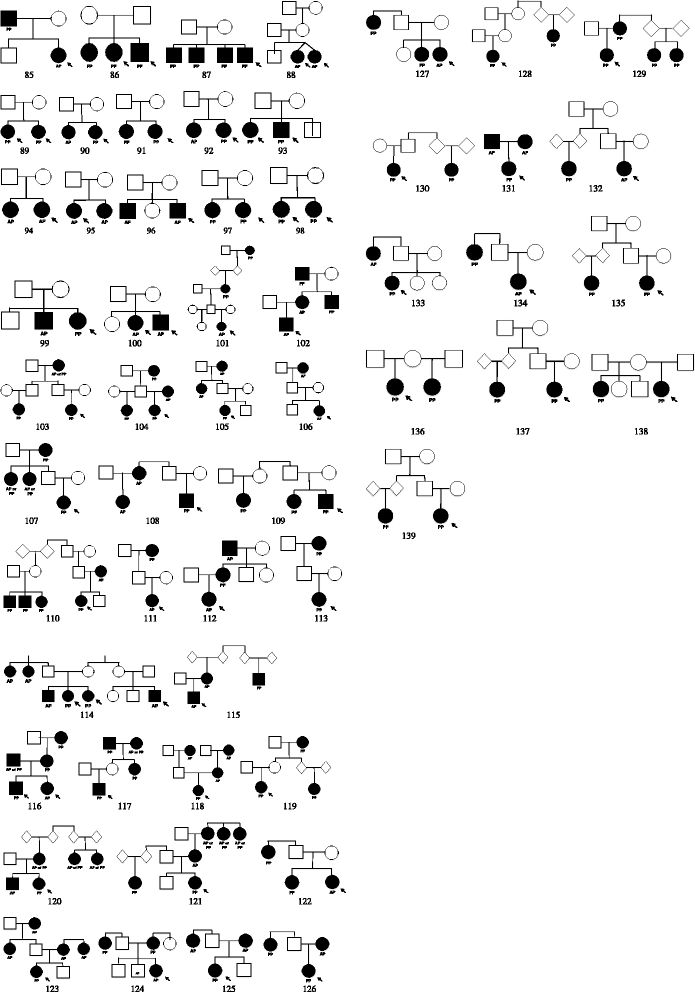Familial early puberty: presentation and inheritance pattern in 139 families
- PMID: 27624871
- PMCID: PMC5022170
- DOI: 10.1186/s12902-016-0130-x
Familial early puberty: presentation and inheritance pattern in 139 families
Abstract
Background: The mechanism that initiates the onset of puberty is largely unknown but the age of onset is mainly under genetic control and influenced by environmental factors including nutrition. The coexistence in the same family of central precocious puberty and advanced puberty, both representing early puberty, suggests that they may represent a clinical spectrum of the same trait due to early activation of the GnRH pulse generator. We therefore evaluated the mode of inheritance of early puberty in a large series of familial cases.
Methods: A retrospective, single center study was carried out on 154 probands (116 girls and 38 boys), from 139 families seen for idiopathic central precocious puberty (onset before 8 years in girls and 9-10 years in boys, n = 93) and/or advanced puberty (onset between 8 and 10 years in girls and 10 and 11 years in boys, n = 61) seen over a period of 8 years.
Results: Of the 139 families, 111 (80.4 %) had at least one affected 1st degree relatives, 17 (12 %) had only 2nd, 5 (3.6 %) only 3rd and 3 (2.2 %) had both 2nd and 3rd degree affected individuals. In the two remaining families, the unaffected mother had affected girls from two unaffected fathers. In the majority of families the inheritance of the phenotype was consistent with autosomal dominant mode of transmission with incomplete penetrance. An exclusively maternal mode of transmission could be observed or inferred in 83 families, paternal in only 2 families (p < 0.0001) and both maternal and paternal modes in 15 families. In the 139 families, 374 cases of early puberty were identified of whom 315 (84.2 %) were affected females and 59 (15.8 %) affected males (p < 0.0001). Twenty one percent of families had exclusively precocious puberty, 25 % had exclusively advanced puberty and 54 % had combinations of both.
Conclusions: The data confirm the high incidence of affected girls with familial early puberty. The mode of inheritance of the phenotype is predominantly maternal. More than half of the families included both precocious and advanced puberty suggesting similar genetic factors.
Keywords: Advanced puberty; Autosomal inheritance; Bilineal inheritance; Central precocious puberty; Early puberty; Familial puberty; GnRH; Hypothalamic-pituitary-gonadal axis; Precocious puberty; Unilineal inheritance.
Figures



Similar articles
-
Constitutional delay of puberty: presentation and inheritance pattern in 48 familial cases.BMC Pediatr. 2016 Mar 12;16:37. doi: 10.1186/s12887-016-0580-3. BMC Pediatr. 2016. PMID: 26970893 Free PMC article.
-
Familial central precocious puberty suggests autosomal dominant inheritance.J Clin Endocrinol Metab. 2004 Apr;89(4):1794-800. doi: 10.1210/jc.2003-030361. J Clin Endocrinol Metab. 2004. PMID: 15070947
-
Clinical and Genetic Characterization of Familial Central Precocious Puberty.J Clin Endocrinol Metab. 2023 Jun 16;108(7):1758-1767. doi: 10.1210/clinem/dgac763. J Clin Endocrinol Metab. 2023. PMID: 36611250
-
Sexual Precocity--Genetic Bases of Central Precocious Puberty and Autonomous Gonadal Activation.Endocr Dev. 2016;29:50-71. doi: 10.1159/000438874. Epub 2015 Dec 17. Endocr Dev. 2016. PMID: 26680572 Review.
-
Precocious puberty: a comprehensive review of literature.J Obstet Gynecol Neonatal Nurs. 2007 May-Jun;36(3):263-74. doi: 10.1111/j.1552-6909.2007.00145.x. J Obstet Gynecol Neonatal Nurs. 2007. PMID: 17489932 Review.
Cited by
-
Prospective associations of adolescent obesity phenotypes with self-reported polycystic ovary syndrome diagnosis in young adulthood.Hum Reprod. 2025 Mar 1;40(3):545-552. doi: 10.1093/humrep/deae294. Hum Reprod. 2025. PMID: 39761509
-
HNF1B nephropathy has a slow-progressive phenotype in childhood-with the exception of very early onset cases: results of the German Multicenter HNF1B Childhood Registry.Pediatr Nephrol. 2019 Jun;34(6):1065-1075. doi: 10.1007/s00467-018-4188-8. Epub 2019 Jan 21. Pediatr Nephrol. 2019. PMID: 30666461
-
DLK1, Notch Signaling and the Timing of Puberty.Semin Reprod Med. 2019 Jul;37(4):174-181. doi: 10.1055/s-0039-3400963. Epub 2020 Jan 23. Semin Reprod Med. 2019. PMID: 31972862 Free PMC article. Review.
-
Comparison of two bone markers with growth evolution in 74 girls with central precocious puberty.BMC Pediatr. 2018 Jul 9;18(1):224. doi: 10.1186/s12887-018-1194-8. BMC Pediatr. 2018. PMID: 29986677 Free PMC article.
-
Effect of hypothyroidism on the hypothalamic-pituitary-ovarian axis and reproductive function of pregnant rats.BMC Endocr Disord. 2018 May 24;18(1):30. doi: 10.1186/s12902-018-0258-y. BMC Endocr Disord. 2018. PMID: 29793475 Free PMC article.
References
-
- Carel J-C, Eugster EA, Rogol A, Ghizzoni L, Palmert MR, on behalf of the members of the ESPE-LWPES GnRH Analogs Consensus Conference Group Consensus statement on the use of gonadotropin-releasing hormone analogs in children. Pediatrics. 2009;123:e752–e762. doi: 10.1542/peds.2008-1783. - DOI - PubMed
-
- Kaprio J, Rimpelä A, Winter T, Viken RJ, Rimpelä M, Rose RJ. Common genetic influences on BMI and age at menarche. Hum Biol. 1995;67:739–753. - PubMed
MeSH terms
LinkOut - more resources
Full Text Sources
Other Literature Sources

